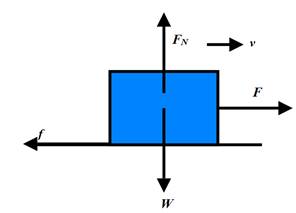
Concept explainers
What can you say about the velocity of a moving body that in dynamic equilibrium? Draw a sketch of such a body using clearly labeled arrows to represent all external forces on the body.
The velocity of a moving body that is dynamic equilibrium and sketch a diagram of such a body.
Answer to Problem 1CQ
The velocity of a body in dynamic equilibrium is a constant, both in magnitude and direction.
Explanation of Solution
Introduction:
A body is said to be in equilibrium if the total force on the body is zero. On this basis, there are two kinds of equilibria- static equilibrium and dynamic equilibrium. According to Newton's first law, a body continues to be in the state of rest or in the state of uniform motion in a straight line, unless acted upon by an external unbalanced force. Further, Newton's second law implies that an unbalanced force produces an acceleration.
The sum of the forces acting on a body which is in dynamic equilibrium is zero. Therefore, the body experiences no acceleration. As a result, its velocity does not change. Thus, the body which is in dynamic equilibrium moves with a constant velocity.
Consider a block of weight W, acted upon by a force F. The block is placed on a horizontal surface. The surface exerts an upward force FNcalled the normal force on the block. A force of friction f acts between the surface and the block. The block moves towards the right with a velocity v.
The forces W and FNare equal and opposite. Thus, the sum of the forces along the vertical direction is zero. If the applied force F and the force of friction f have equal magnitudes but they are directed opposite to each other. Thus, the net force along the horizontal is also equal to zero. The sum of the forces acting on the block, being zero, the block is not accelerated. Thus, the velocity of the block remains constant. It continues to move with the same speed v and in the same direction.
A diagram representing the forces is shown below.

Conclusion:
A moving body under dynamic equilibrium moves with a constant velocity.
Want to see more full solutions like this?
Chapter 9 Solutions
College Physics
Additional Science Textbook Solutions
Biology: Life on Earth with Physiology (11th Edition)
Applications and Investigations in Earth Science (9th Edition)
Human Anatomy & Physiology (2nd Edition)
Physics for Scientists and Engineers: A Strategic Approach, Vol. 1 (Chs 1-21) (4th Edition)
Campbell Essential Biology (7th Edition)
College Physics: A Strategic Approach (3rd Edition)
- Pls help ASAParrow_forward14. A boy is out walking his dog. From his house, he walks 30 m North, then 23 m East, then 120 cm South, then 95 m West, and finally 10 m East. Draw a diagram showing the path that the boy walked, his total displacement, and then determine the magnitude and direction of his total displacement.arrow_forwardPls help ASAParrow_forward
- 12. A motorboat traveling 6 m/s, West encounters a water current travelling 3.5 m/s, South. a) Draw a vector diagram showing the resultant velocity, then determine the resultant velocity of the motorboat. b) If the width of the river is 112 m wide, then how much time does it take for the boat to travel shore to shore? c) What distance downstream does the boat reach the opposite shore?arrow_forwardLake Erie contains roughly 4.00⋅10114.00⋅1011 m3 of water. Assume the density of this water is 1000. kg/m3 and the specific heat of water is 4186 J/kg˚C. It takes 2.31x10^19 J of energy to raise the temperature of that volume of water from 12.0 °C to 25.8 ˚C. An electric power plant can produce about 1110 MW. How many years would it take to supply this amount of energy by using the 1110 MW from an electric power plant?arrow_forwardPls help ASAParrow_forward
- Pls help ASAParrow_forwardm m $2° 15. A truck is stopped at a red light. Once the light turns green, the truck accelerates forward at 1.75- that same instant, a car moving with a constant speed of 50 — passes the truck. a) How many seconds will it take for the truck to catch up to the car? S b) How many metres will the truck travel before it catches up to the car? Atarrow_forwardPls help ASAParrow_forward
 Physics for Scientists and Engineers: Foundations...PhysicsISBN:9781133939146Author:Katz, Debora M.Publisher:Cengage Learning
Physics for Scientists and Engineers: Foundations...PhysicsISBN:9781133939146Author:Katz, Debora M.Publisher:Cengage Learning Glencoe Physics: Principles and Problems, Student...PhysicsISBN:9780078807213Author:Paul W. ZitzewitzPublisher:Glencoe/McGraw-Hill
Glencoe Physics: Principles and Problems, Student...PhysicsISBN:9780078807213Author:Paul W. ZitzewitzPublisher:Glencoe/McGraw-Hill College PhysicsPhysicsISBN:9781938168000Author:Paul Peter Urone, Roger HinrichsPublisher:OpenStax College
College PhysicsPhysicsISBN:9781938168000Author:Paul Peter Urone, Roger HinrichsPublisher:OpenStax College Principles of Physics: A Calculus-Based TextPhysicsISBN:9781133104261Author:Raymond A. Serway, John W. JewettPublisher:Cengage Learning
Principles of Physics: A Calculus-Based TextPhysicsISBN:9781133104261Author:Raymond A. Serway, John W. JewettPublisher:Cengage Learning College PhysicsPhysicsISBN:9781285737027Author:Raymond A. Serway, Chris VuillePublisher:Cengage Learning
College PhysicsPhysicsISBN:9781285737027Author:Raymond A. Serway, Chris VuillePublisher:Cengage Learning College PhysicsPhysicsISBN:9781305952300Author:Raymond A. Serway, Chris VuillePublisher:Cengage Learning
College PhysicsPhysicsISBN:9781305952300Author:Raymond A. Serway, Chris VuillePublisher:Cengage Learning





